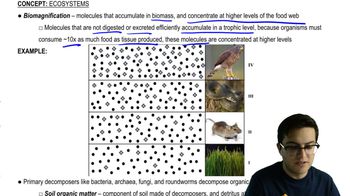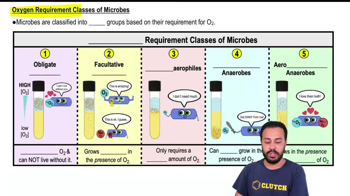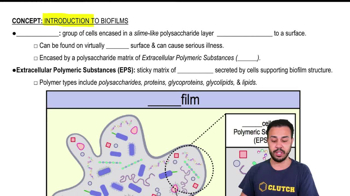Table of contents
- 1. Introduction to Biology2h 42m
- 2. Chemistry3h 40m
- 3. Water1h 26m
- 4. Biomolecules2h 23m
- 5. Cell Components2h 26m
- 6. The Membrane2h 31m
- 7. Energy and Metabolism2h 0m
- 8. Respiration2h 40m
- 9. Photosynthesis2h 49m
- 10. Cell Signaling59m
- 11. Cell Division2h 47m
- 12. Meiosis2h 0m
- 13. Mendelian Genetics4h 44m
- Introduction to Mendel's Experiments7m
- Genotype vs. Phenotype17m
- Punnett Squares13m
- Mendel's Experiments26m
- Mendel's Laws18m
- Monohybrid Crosses19m
- Test Crosses14m
- Dihybrid Crosses20m
- Punnett Square Probability26m
- Incomplete Dominance vs. Codominance20m
- Epistasis7m
- Non-Mendelian Genetics12m
- Pedigrees6m
- Autosomal Inheritance21m
- Sex-Linked Inheritance43m
- X-Inactivation9m
- 14. DNA Synthesis2h 27m
- 15. Gene Expression3h 20m
- 16. Regulation of Expression3h 31m
- Introduction to Regulation of Gene Expression13m
- Prokaryotic Gene Regulation via Operons27m
- The Lac Operon21m
- Glucose's Impact on Lac Operon25m
- The Trp Operon20m
- Review of the Lac Operon & Trp Operon11m
- Introduction to Eukaryotic Gene Regulation9m
- Eukaryotic Chromatin Modifications16m
- Eukaryotic Transcriptional Control22m
- Eukaryotic Post-Transcriptional Regulation28m
- Eukaryotic Post-Translational Regulation13m
- 17. Viruses37m
- 18. Biotechnology2h 58m
- 19. Genomics17m
- 20. Development1h 5m
- 21. Evolution3h 1m
- 22. Evolution of Populations3h 52m
- 23. Speciation1h 37m
- 24. History of Life on Earth2h 6m
- 25. Phylogeny2h 31m
- 26. Prokaryotes4h 59m
- 27. Protists1h 12m
- 28. Plants1h 22m
- 29. Fungi36m
- 30. Overview of Animals34m
- 31. Invertebrates1h 2m
- 32. Vertebrates50m
- 33. Plant Anatomy1h 3m
- 34. Vascular Plant Transport1h 2m
- 35. Soil37m
- 36. Plant Reproduction47m
- 37. Plant Sensation and Response1h 9m
- 38. Animal Form and Function1h 19m
- 39. Digestive System1h 10m
- 40. Circulatory System1h 57m
- 41. Immune System1h 12m
- 42. Osmoregulation and Excretion50m
- 43. Endocrine System1h 4m
- 44. Animal Reproduction1h 2m
- 45. Nervous System1h 55m
- 46. Sensory Systems46m
- 47. Muscle Systems23m
- 48. Ecology3h 11m
- Introduction to Ecology20m
- Biogeography14m
- Earth's Climate Patterns50m
- Introduction to Terrestrial Biomes10m
- Terrestrial Biomes: Near Equator13m
- Terrestrial Biomes: Temperate Regions10m
- Terrestrial Biomes: Northern Regions15m
- Introduction to Aquatic Biomes27m
- Freshwater Aquatic Biomes14m
- Marine Aquatic Biomes13m
- 49. Animal Behavior28m
- 50. Population Ecology3h 41m
- Introduction to Population Ecology28m
- Population Sampling Methods23m
- Life History12m
- Population Demography17m
- Factors Limiting Population Growth14m
- Introduction to Population Growth Models22m
- Linear Population Growth6m
- Exponential Population Growth29m
- Logistic Population Growth32m
- r/K Selection10m
- The Human Population22m
- 51. Community Ecology2h 46m
- Introduction to Community Ecology2m
- Introduction to Community Interactions9m
- Community Interactions: Competition (-/-)38m
- Community Interactions: Exploitation (+/-)23m
- Community Interactions: Mutualism (+/+) & Commensalism (+/0)9m
- Community Structure35m
- Community Dynamics26m
- Geographic Impact on Communities21m
- 52. Ecosystems2h 36m
- 53. Conservation Biology24m
26. Prokaryotes
Prokaryotic Metabolism
Problem 5`
Textbook Question
Bacteria perform the following ecological roles. Which role typically does not involve symbiosis?
a. Skin commensalist
b. Decomposer
c. Gut mutualist
d. Pathogen
 Verified step by step guidance
Verified step by step guidance1
Understand the concept of symbiosis: Symbiosis refers to a close and long-term biological interaction between two different biological organisms. It can be mutualistic, commensalistic, or parasitic.
Identify the roles listed in the problem: The roles are skin commensalist, decomposer, gut mutualist, and pathogen.
Analyze each role: Determine if each role involves symbiosis. A skin commensalist lives on the skin without harming the host, which is a form of symbiosis. A gut mutualist benefits both the host and the bacteria, which is mutualistic symbiosis. A pathogen harms the host, which is parasitic symbiosis.
Consider the role of decomposers: Decomposers break down dead organic matter, recycling nutrients back into the ecosystem. This process typically occurs independently of a host organism, thus not involving symbiosis.
Conclude which role does not involve symbiosis: Based on the analysis, decomposers typically do not engage in symbiotic relationships as they act independently of living hosts.
 Verified video answer for a similar problem:
Verified video answer for a similar problem:This video solution was recommended by our tutors as helpful for the problem above
Video duration:
1mPlay a video:
Was this helpful?
Key Concepts
Here are the essential concepts you must grasp in order to answer the question correctly.
Symbiosis
Symbiosis refers to a close and long-term biological interaction between two different biological organisms. It can be mutualistic, commensalistic, or parasitic, where both, one, or neither organism benefits, respectively. Understanding symbiosis is crucial to differentiate roles that involve direct interactions between organisms.
Recommended video:
Guided course

Symbiosis
Decomposer
Decomposers are organisms, such as bacteria and fungi, that break down dead or decaying organisms, recycling nutrients back into the ecosystem. This role typically does not involve symbiosis, as decomposers act independently to process organic matter, unlike symbiotic relationships that require interaction with living hosts.
Recommended video:
Guided course

Biomagnification and Decomposers
Pathogen
Pathogens are organisms that cause disease in their host, often through parasitic relationships. While pathogens can be considered a form of symbiosis due to their interaction with hosts, they differ from mutualistic or commensalistic relationships as they harm the host, highlighting the diverse nature of symbiotic interactions.
Recommended video:
Guided course

Pathogen Defenses

 2:57m
2:57mWatch next
Master Nutritional Factors of Microbial Growth with a bite sized video explanation from Jason
Start learningRelated Videos
Related Practice












